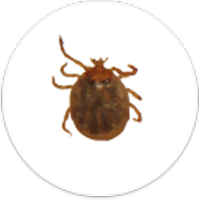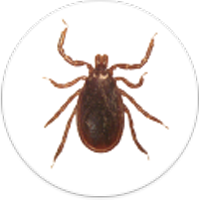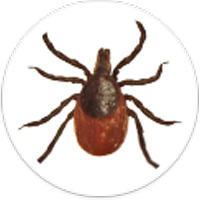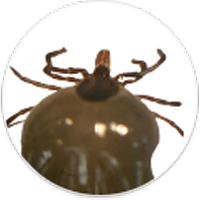Blacklegged tick (deer tick)
Ixodes scapulars
Western blacklegged tick
Ixodes pacificus
Identification
These ticks are closely related and would be difficult to tell apart with the naked eye.16 They’re dark brown to black with no white markings.17

Nymph

Male

Female

Engorged Female
Approximate Distribution

The blacklegged (deer) tick can be found throughout the eastern United States and west to Texas and South Dakota.17
The western blacklegged tick is primarily found along coastal areas in states west of the Rocky Mountains.17
Hosts

Both species of ticks can be found on medium to large mammals, such as deer, in their adult stage. In immature stages, their hosts include lizards, birds, small rodents, and small mammals.17
Habitat

Both species are most commonly found in leaf litter on the ground in natural wooded areas that are frequented by wildlife. This can include forest edges near homes and public recreation areas.17
Diseases associated with Ixodes scapularis and Ixodes pacificus20
Anaplasmosis is caused by the bacteria Anaplasma phagocytophilum. It primarily affects dogs (infection in cats is rare). Dog with anaplasmosis may never show signs of illness or require treatment. Those that do commonly respond to antibiotics.23
Clinical Signs
In dogs:23
● Decreased energy
● Decreased appetite
● Dehydration
● Some dogs may show no signs
Diagnosis and testing
To diagnose anaplasmosis, your veterinarian will usually use a blood test to detect antibodies. In some cases, a positive antibody test might indicate previous exposure, rather than an active infection needing treatment.23
Treatment
The antibiotic doxycycline is commonly used to treat anaplasmosis. Dogs often start to feel better in one or two days after starting antibiotics, but treatment should continue for at least two weeks. If a dog tests positive for the antibody but shows no signs of the disease, antibiotic treatment is not required.23
References:
23. Anaplasmosis. Cornell Richard P. Riney Canine Health Center. https://www.vet.cornell.edu/departments/riney-canine-health-center/canine-health-information/anaplasmosis
Lyme disease, or borreliosis, is caused by the Borrelia bacteria. It affects both dogs and cats, though it occurs less frequently in cats. Laboratory studies show that cats that are treated promptly have a good chance of full recovery. Left untreated, Lyme disease in dogs can progress to kidney failure and can even be fatal. It may also cause neurological and cardiac issues in dogs.
Clinical Signs
In cats:27
● Fever
● Loss of appetite
● Fatigue
● Difficulty breathing
In dogs:28
● Loss of appetite
● Painful or swollen joints
● Lameness that comes and goes
● Swollen lymph nodes
● Decreased energy
Diagnosis and testing
When diagnosing Lyme disease, your veterinarian will likely take a thorough approach that may include your pet’s medical history, any signs your pet is showing, your pet’s response to treatment, and laboratory data from blood testing and tissue cultures.29
Treatment
Lyme disease in pets is typically treated with antibiotics, specifically doxycycline for dogs.27, 28 Veterinarians may also prescribe gabapentin to dogs infected with Lyme to help manage pain associated with the disease.29
References:
27. Lyme Disease (Lyme Borreliosis) in Cats. Merck Vet Manual. https://www.merckvetmanual.com/cat-owners/disorders-affecting-multiple-body-systems-of-cats/lyme-disease-lyme-borreliosis-in-cats
28. Lyme Disease (Lyme Borreliosis) in Dogs. Merck Vet Manual. https://www.merckvetmanual.com/dog-owners/disorders-affecting-multiple-body-systems-of-dogs/lyme-disease-lyme-borreliosis-in-dogs
29. Lyme Borreliosis in Animals. Merck Vet Manual. https://www.merckvetmanual.com/generalized-conditions/lyme-borreliosis/lyme-borreliosis-in-animals
Ehrlichiosis is a serious disease caused by the Ehrlichia bacteria. It affects both dogs and cats.33, 34
Clinical Signs
In dogs and cats: 33, 34
● Swollen lymph nodes
● Loss of appetite
● Depression
● Muscle stiffness
● Coughing
If the disease progresses, long-term signs include bleeding and bruising caused by low levels of platelets in the blood.
Diagnosis and testing
Diagnosing ehrlichiosis involves a combination of observing clinical signs and conducting blood and laboratory tests, which help confirm the presence of the Ehrlichia organism and assess the severity of the infection.33, 34
Treatment
The primary treatment for ehrlichiosis in both dogs and cats typically involves the use of doxycycline, an antibiotic. It can also include supportive care to address symptoms and keep your pet more comfortable.35
References:
33. Ehrlichiosis and Related Infections in Dogs. Merck Vet Manual. https://www.merckvetmanual.com/dog-owners/disorders-affecting-multiple-body-systems-of-dogs/ehrlichiosis-and-related-infections-in-dogs
34. Ehrlichiosis and Related Infections in Cats. Merck Vet Manual. https://www.merckvetmanual.com/cat-owners/disorders-affecting-multiple-body-systems-of-cats/ehrlichiosis-and-related-infections-in-cats
35. Ehrlichiosis, Anaplasmosis, and Related Infections in Animals. Merck Vet Manual. https://www.merckvetmanual.com/generalized-conditions/rickettsial-diseases/ehrlichiosis,-anaplasmosis,-and-related-infections-in-animals
References:
17. Ixodes Scapularis and Ixodes Pacificus. Companion Animal Parasite Council. https://capcvet.org/guidelines/ixodes-scapularis-and-ixodes-pacificus/
20. Ticks. Companion Animal Parasite Council. https://capcvet.org/guidelines/ticks/

 Go To United States
Go To United States Austria
Austria Belgium
Belgium Czech Republic
Czech Republic Denmark
Denmark Europe
Europe Finland
Finland France
France Germany
Germany Greece
Greece Hungary
Hungary Ireland
Ireland Israel
Israel Italy
Italy Netherlands
Netherlands Norway
Norway Poland
Poland Portugal
Portugal Romania
Romania Spain
Spain Sweden
Sweden Turkey
Turkey United Kingdom
United Kingdom